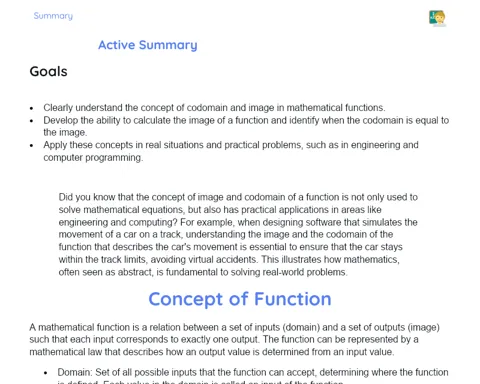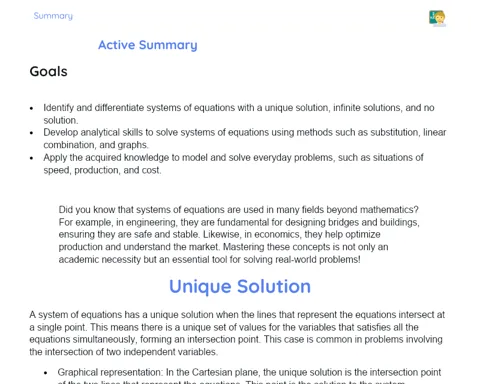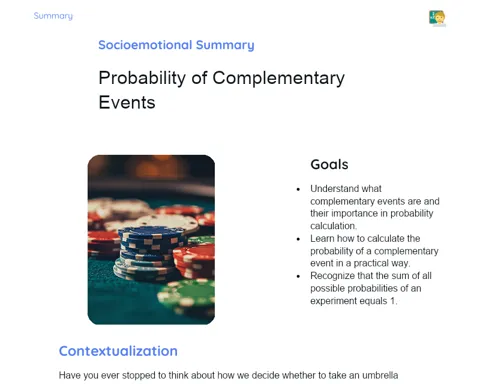Master the Decimal System: Theory and Practice
Objectives
1. Read and write rational numbers with finite representation in decimal form appropriately.
2. Recognize and differentiate digits by their names and positions, such as in the number 100, where the 1 is the hundreds digit.
Contextualization
The decimal system is the basis of many activities in our daily lives, from counting money to reading measurements in different contexts, such as in the kitchen or in construction. Understanding how numbers are formed and represented helps us perform these tasks accurately and efficiently. For example, when shopping, we need to calculate change and sum prices, while in the kitchen, we measure ingredients for a recipe accurately.
Relevance of the Theme
The decimal system is used in practically every professional area. Engineers use decimal measurements to ensure the precision of projects, accountants and economists rely on the accuracy of decimal numbers to perform financial calculations and make economic decisions. Additionally, programmers often work with decimal numbers in calculations and algorithms. Therefore, mastering the decimal system is essential for both academic success and professional life.
Reading and Writing Rational Numbers in Decimal Form
Reading and writing rational numbers in decimal form involves understanding how numbers are represented after the decimal point. This skill is fundamental for various daily activities, such as reading prices, measurements, and grades. Furthermore, it is essential for precision in mathematical calculations.
-
Understand the position of digits after the decimal point (tenths, hundredths, thousandths).
-
Practice the correct reading of decimal numbers.
-
Write rational numbers in their decimal form correctly.
Identification and Naming of Digits by Position
Each position of a digit in a decimal number has a specific value, such as units, tens, hundreds, tenths, hundredths, etc. Recognizing and naming these positions is crucial for the correct interpretation and manipulation of numbers.
-
Identify the position of digits in a number (units, tens, hundreds, etc.).
-
Correctly name the positions of the digits.
-
Understand the importance of the position of digits for the precision of calculations.
Conversion of Simple Fractions to Decimals
Converting simple fractions to decimals is a skill that facilitates calculations and value comparisons. This process involves dividing the numerator by the denominator to obtain the decimal representation of the fraction.
-
Understand the concept of fractions and their relation to decimals.
-
Perform the division of the numerator by the denominator to obtain the decimal.
-
Practice converting various fractions to decimals.
Practical Applications
- Engineering: Use of decimal measurements to ensure project precision.
- Accounting: Performing financial calculations with decimal numbers to ensure accuracy.
- Technology: Programming algorithms that involve calculations with decimal numbers.
Key Terms
-
Decimal System: A numbering system based on powers of 10.
-
Rational Numbers: Numbers that can be expressed as a fraction of two integers.
-
Terminating Decimal: Decimal representation of a rational number that ends with a finite number of digits after the decimal point.
Questions
-
How does knowledge of the decimal system facilitate daily activities?
-
In what professional situations do you think the precision of decimal numbers is crucial?
-
How can understanding decimal numbers influence your financial decisions?
Conclusion
To Reflect
Knowledge of the decimal system is an essential skill that assists us in various daily activities, such as calculating change, measuring ingredients, reading measurements in projects, and much more. Furthermore, this skill is vital in various professions, such as engineering, accounting, and technology, where precision in calculations is crucial. Reflecting on how we use decimal numbers in different contexts helps us understand the importance of this skill and apply it effectively in our lives.
Mini Challenge - Decimal Transformation Challenge
This mini-challenge aims to consolidate your understanding of reading and writing rational numbers in decimal form, as well as identifying the positions of the digits.
- Write the following rational numbers in decimal form: 2/5, 7/8, 9/20, 3/25.
- Identify and name the position of the digits in the number 205.67.
- Convert the following decimal numbers to simple fractions: 0.2; 0.875; 0.45; 0.12.
- Write a short paragraph (4-5 lines) explaining how you used the decimal system in a recent activity, such as shopping or cooking.



